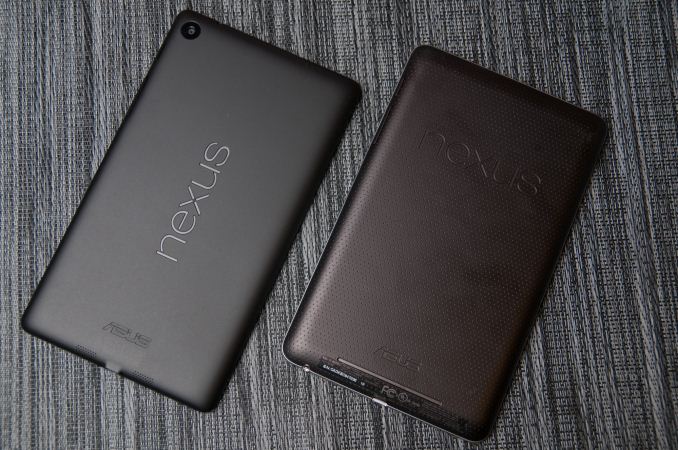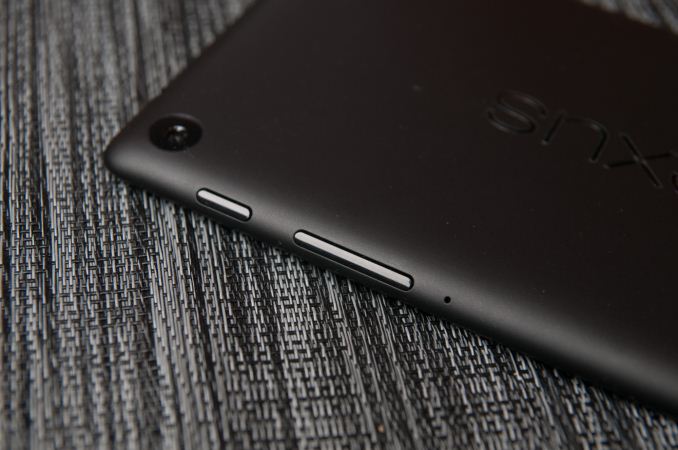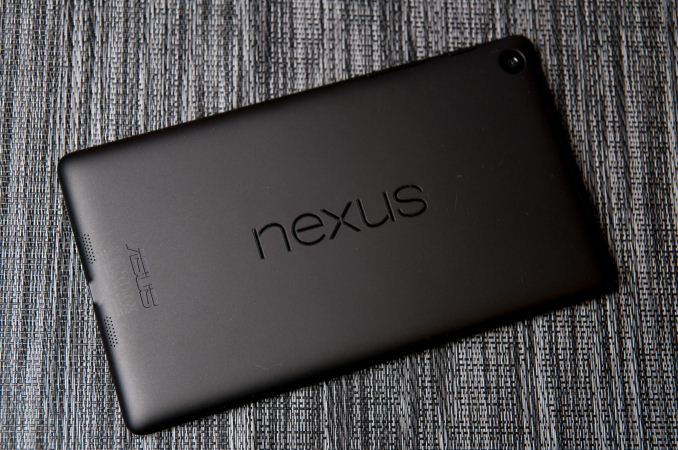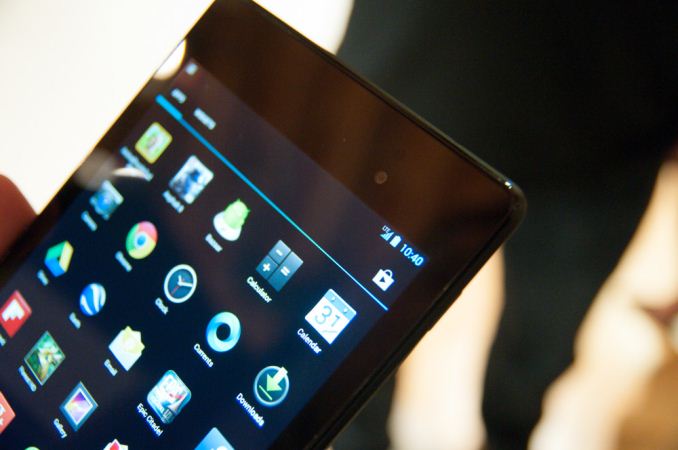Nexus 7 (2013) - Mini Review
by Brian Klug on July 27, 2013 12:54 AM EST- Posted in
- Tablets
- Snapdragon
- Qualcomm
- Android
- Mobile
- APQ8064
- Nexus 7
- Android 4.3

At an event in San Francisco, Google announced an updated version of the popular Nexus 7 tablet which first appeared at last year’s Google I/O. The big new features update the Nexus 7 platform with inclusion of a 1.5 GHz Snapdragon S4 Pro (APQ8064) SoC, 1920x1200 display by JDI (Japan Display Inc), as well as 5 MP rear facing camera, 1.2 MP front facing camera, stereo speakers, dual band WiFI, wireless charging (Qi) and a thinner and lighter chassis. It’s a major update that keeps the competitive price point that made the original Nexus 7 appealing (the lineup starts at $229 for the 16 GB model) while bringing numerous much-needed improvements that people have asked for.
First off, it’s shocking how much of a difference the change in thickness and weight makes. The new Nexus 7 feels considerably lighter and thinner in the hand than its older counterpart. Gone is the textured rubberized (almost driver glove-like) material on the back, in its place a flat, uniform soft touch material. There’s Nexus emblazoned in landscape on the rear, which is a bit puzzling next to the 90 degree rotated ASUS down below. It irritates my OCD sensibilities seeing the two logos inexplicably perpendicular and right next to each other, but I suppose Google thinks this helps emphasize how much the Nexus 7 and Android platform are really tablet-friendly now, with landscape view support throughout the core apps.
The rear facing camera is in the extreme top left, next to the power and volume rocker buttons, and top speaker. The Nexus 7 build and finish does feel a bit more plasticky to me this time around, but that’s almost expected given the price point, and it isn’t a major dig on the hardware at all. That’s not to say it isn’t sturdy or well put together, but just that the original Nexus 7 left a stronger impression on me last time, and I’ve been spoiled by the ASUS FonePad since then. The edge chamfer also helps the Nexus 7 feel a bit more like the Nexus 4 with its rounded edge. The previous Nexus 7 came to a point that could be a bit sharp at times.
What’s a little awkward is how tall the bezel at top and bottom looks on the Nexus 7, I’m warming up to it. On paper the new Nexus 7 is smaller in almost every dimension, in reality the elongated aspect ratio is definitely a bit pronounced here. There’s also still a notification LED well hidden under the glass at bottom in the center.
On the back is the new 5 MP rear facing camera, buttons (which hug the edges), a microphone port, and speakers. The speakers fire out the back of the Nexus 7 and look like they have good separation (obviously the best that the device’s size affords – top and bottom), but I don’t have a good feel for just how loud they go quite yet. Having stereo is a dramatic improvement for the audio part of video and multimedia consumption, and Android does 5.1 virtualization out the speakers as well. On the connectivity side of things there’s microUSB at the bottom with SlimPort video out, and a 3.5mm audio jack. I know a lot of people were hoping for inclusion of line in on the 3.5mm audio jack but I can confirm it isn’t present.
| Nexus 7Tablet Specification Comparison | ||||
| ASUS Nexus 7 (2012) | ASUS Nexus 7 (2013) | |||
| Dimensions | 198.5 x 120 x 10.45mm | 200 x 114 x 8.65mm | ||
| Chassis | Plastic + Rubber back | Plastic + Soft Touch back | ||
| Display | 7-inch 1280x800 IPS | 7.02-inch 1920x1200 IPS | ||
| Weight | 340 g | 290 grams (WiFi), 299 grams (LTE) | ||
| Processor | 1.3 GHz NVIDIA Tegra 3 (T30L - 4 x Cortex A9) | 1.5 GHz Qualcomm Snapdragon S4 Pro (APQ8064) | ||
| Memory | 1 GB | 2 GB DDR3L | ||
| Storage | 8 GB / 16 GB | 16 GB / 32 GB | ||
| Battery | 16 Whr | 15.01 Whr | ||
| WiFi/Connectivity | 802.11b/g/n, BT, NFC | 802.11a/b/g/n, BT 4.0, NFC | ||
| Camera | – |
5.0 MP Rear Facing w/AF 1.2MP Front Facing |
||
| Wireless Charging | – | Yes (Qi Compatible) | ||
| Pricing | $199/$249 |
$229/$269 (WiFi 16/32 GB) $349 (LTE) |
||
My only real complaint with the new Nexus 7’s in hand feel and build is with the power button and volume rocker, which feel somewhat mushy to me. I had issues taking screenshots even at times. It’s a minor gripe, but with only three buttons on the whole device, and generally good execution by ASUS with buttons on tablets, it surprised me. I guess I also do miss that racing glove-inspired texture in the soft touch on the back of the original Nexus 7.
| Nexus 7 (LTE) Band Coverage | |||||
| Model | GSM/EDGE Bands |
WCDMA Bands (HSPA+ 42) |
LTE Bands (UE Category 3) |
||
| North America Nexus 7 LTE |
Quad Band (850 / 900 / 1800 / 1900 MHz) |
HSPA+: 850/900/1900/2100/AWS(1700/2100) MHz (Bands: 1/2/4/5/8) | 700/750/850/1700/1900/2100 MHz (Bands: 1/2/4/5/13/17) | ||
| Europe Nexus 7 LTE | 800/850/1700/1800/1900/2100/2600 MHz (Bands: 1/2/3/4/5/7/20) | ||||
There’s a version of the Nexus 7 with 32 GB of storage and LTE onboard for $349 which will appear ‘in the coming weeks’ and includes support for AT&T, T-Mobile, and Verizon LTE in the USA on one piece of hardware. This is the first single SKU solution I’m aware of with coexistence of Bands 13 and 17 (Verizon and AT&T respectively) on the same device, which is awesome. There’s a model with Bands 3, 7, and 20 for Europe as well, so they’re not left out of the LTE fray. I had a chance to quickly get a look at the new Nexus 7 with LTE, which includes a microSIM tray and was working on one of the LTE networks in San Francisco just fine.
As far as I know, the Nexus 7 LTE solution is Qualcomm’s MDM9215 with a WTR1605L transceiver inside, and doesn’t necessarily include any of the new RF360 brand of front end hardware (like the power amplifier with integrated antenna switch or tunable front end), since MDM9x15 only works with QFE1320 (Bands 1,2,3/4,5,8,20). Still, that makes it all the more impressive, and Google deserves considerable kudos for further pushing such unprecedented interoperability, since in a tablet you do have more area to include discrete power amplifiers and filters.




















252 Comments
View All Comments
doobydoo - Thursday, August 1, 2013 - link
I guess this it what happens when you compare devices nearly a year apart...smartypnt4 - Saturday, July 27, 2013 - link
I'll have to agree with you and others here. I do much prefer the 8" size to 7" (as an aside, the 8" 16:10 seems to be the best of both worlds that I've used. Sadly only Samsung makes one of those.), but that screen would have me buying the N7 every time.I've used the iPad Mini countless times trying to convince myself the low PPI and comparatively worse color accuracy (vs. my current 4th gen iPad) wouldn't matter, but I can't sell myself on it. The screen on the mini is disgraceful in 2013. By pure numbers, it traded blows (and was often beat) by the 2012 Nexus 7, to say nothing of the 2013 N7. I can't deal with a screen like that in 2013. Not when it'd become the worst screen I use daily.
Now that the N7 is out, honestly, Apple has no excuse not to show up with a "retina" iPad mini this fall. If they do, it'll be a tough choice for me to make on which to get, but at that point, you really can't lose. If I was buying this instant, there's no competition. The Nexus 7 has too many advantages over the Mini for me. I understand if you value form factor to the exclusion of everything else, though. I've been known to do that myself on occasion.
guidryp - Saturday, July 27, 2013 - link
"Now that N7 is out", doesn't really apply, the iPad Mini design was likely set in stone 6 months ago. They can't just change their mind when someone ships something better than expected.I think we are only 50% likely to see a Retina Mini and if we do, the price will likely go up as well, so it still won't be huge competition for the N7.
smartypnt4 - Saturday, July 27, 2013 - link
My point was this: previously, it was speculated that the iPad mini in "retina" guise didn't exist Due to the technical limitations presented by trying to pack a screen like that into a chassis this small and light. Now that ASUS/Google have made it apparent that something can be performant and thin and light, while having a screen that's about on par with the iPad 4 in terms of color and contrast, no Apple apologist can claim that there are technical limitations on creating an iPad mini with an awesome screen.Unfortunately, I have a feeling that you're right on the likelihood of getting a retina mini. Then again, I was adamant that the iPad 3 wouldn't have a 2048x1536 screen, so what the hell do I know? And if it does so happen that ewe see a retina mini, I doubt it'll be in any way a competitor to the Nexus 7 due to the cost of the thing. I'd love to see it stay at $330 to keep some semblance of competition alive, but I'm starting to doubt that'll happen. Only time will tell, I suppose.
doobydoo - Thursday, August 1, 2013 - link
Well arguably they haven't done it properly - because the FPS we're seeing on all of the onscreen benchmarks it vastly inferior to that on the iPad Mini.Anyone can shove a high res screen in, but packing the power to drive that screen was the challenge, and I don't think Google (Asus) have done this.
Also - the iPad Mini was not retina because it was released nearly a year ago, technology changes.
doobydoo - Thursday, August 1, 2013 - link
I doubt they'd push the price up - they didn't when they made the iPad retina.Impulses - Sunday, July 28, 2013 - link
8" 16:10 would be my preference too, but for $230 and being a Nexus device I'll easily settle for 7". I can't stand 4:3 and I can't fathom why a ton of people seem to enjoy web browsing in landscape (even with 16:10 tablets!).Mugur - Monday, July 29, 2013 - link
... and I though I was alone. Yes, after playing with all sizes, 8" 16:10 seems to be the option I like best. But this Nexus looks so nice... :-)zhenya00 - Sunday, July 28, 2013 - link
The N7 doesn't show 1920x1200 pixels of content though. I presume that the new N7, like the old, shows some lesser number of points, probably still 960x600 points, meaning that it has less effective resolution than the mini, especially in width where you'll notice that it is often unable to show the entire width of a web page. In my opinion this is what makes the iPad so perfect for web browsing; it fits the majority of modern web pages perfectly in portrait orientation with no wasted space and no side-scrolling necessary.abazigal - Sunday, July 28, 2013 - link
I expect the ipad mini 2 to be identical to the ipad4 in terms of specs. A6x processor, 1gb of ram, 326 PPI (little reason to go higher when retina apps run well on such specs). We may see a 8mp camera, but otherwise, I don't see much differentiating it from the Nesux7 apart from ecosystem.Let's admit it. For all this comparisons, the Apple users are still going to stick with an ipad, while the Android users are going to get the Nexus7, simple because they are all too deeply invested in their ecosystem of choice to consider switching camp. You have your google play, I have my app store. I value my airplay mirroring just as you want to root your ROM.